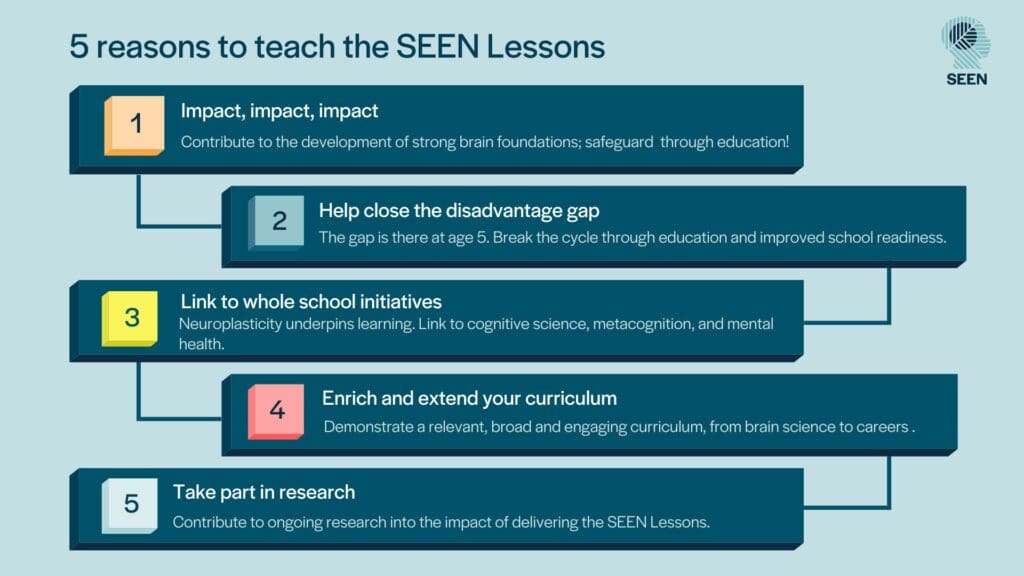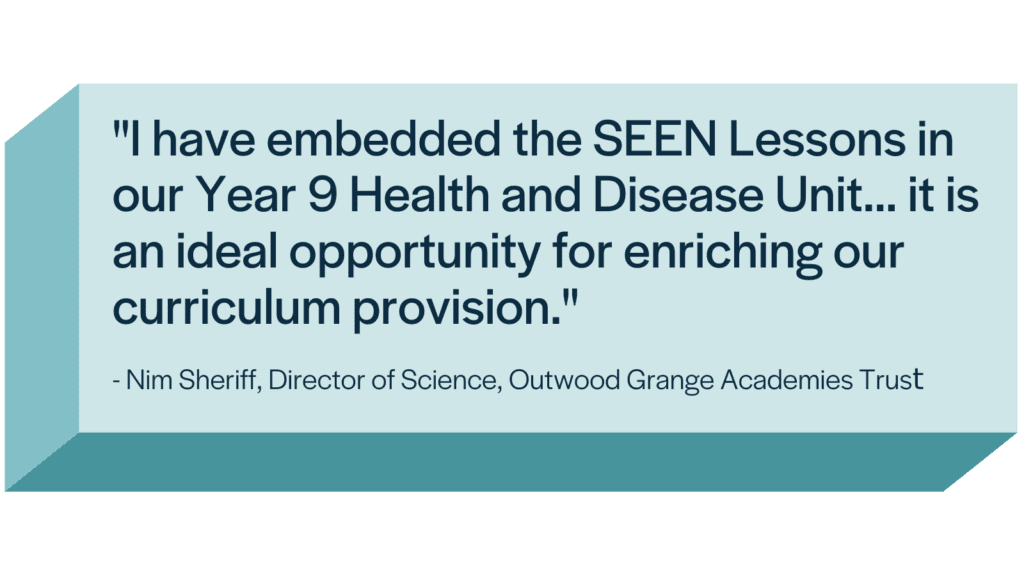The SEEN Blog #1 | 5 reasons why EVERY school should teach the SEEN Lessons
I may be biased, but bear with me.
When I left the science classroom almost 5 years ago I had 2 things I wanted to do. Find a way to teach teenagers about their brains (why don’t we teach much brain science in schools?) and find viable ways to help teenagers manage their day-to-day stresses and flourish, (beyond academic performance). Being a researcher at the University of Oxford’s Department of Psychiatry gave me ample opportunity to think, read, and research (a luxury not afforded as a classroom teacher).
During Covid I took a sideways step from teenagers… to the early years. I took on the management of a curriculum research project on early brain development, commissioned and funded by Kindred2. I figured it was a year long project, during uncertain times, and it would no doubt enhance my understanding of the adolescent brain and links to mental health in schools, that I continued to work on in my non-academic work life. 18 months on, now leading the SEEN Programme for Kindred2, and I am still amazed at how Iittle I had known about this crucial period of development. So for my first blog I want to tell you why I think every school should be teaching about early brain development.

Reason 1: impact, impact, impact
Scientists know that pregnancy and the first years of a child’s life have a lasting impact on their long-term physical and mental health, learning and earnings potential. If we want to have the greatest impact on life outcomes, then this is the time to do it. In the words of Harvard’s Centre for the Developing Child “It is more effective and more efficient to get things right the first time than to try to fix them later” [1] .

Brains are built bottom up. The basic circuits are built in the first years of a baby’s life and are the foundations on which other circuits are built later in life. As the third pig knows, building a house out of bricks, with strong foundations, is more likely than straw or sticks to cope with the challenges faced in life!
Even though this period is so critical, and the education system is always talking about impact… there is no universal education about how to support healthy brain development during this time. The SEEN Programme hopes to change this. Just 3 lessons, covering curriculum content identified by experts in the field of psychiatry, child development and psychology, as essential core knowledge. Free and fully resourced for any school to use. No, I can’t tell you definitively that having this knowledge will change the outcomes for future generations, but at least it is a start and will raise the profile of this crucial period for all members of society.

Reason 2: Help close the disadvantage gap
In their annual report on Education in England, the Education Policy Institute point out that disadvantaged pupils in reception year are already 4.6 months behind their non-disadvantaged peers (2019)[2]. The gap is greatest for areas with the largest proportion of students in long term poverty. It also identified the increasing proportion of disadvantaged children in persistent poverty as a contributory cause of the lack of progress with narrowing the disadvantage gap. Findings from a recent study published by UCL about adverse childhood experiences or ACEs (such as maltreatment, parents with mental health problems, parental divorce, abuse) also demonstrated a link between poverty and ACEs [3]. In a recent YouGov poll teachers on average reported that only 50% of children were school ready in 2021. The combination of poverty, increased likelihood of ACEs and low levels of school readiness means that many children are starting school in reception already trying to play catch up to their peers.

At Kindred2, we hope that the introduction of a universal education about the importance of early childhood experiences is just one way of addressing this issue. By learning at school about positive experiences for growing a healthy brain in the early years, current and future generations may use this knowledge and skills to improve conditions for all young children.
Reason 3: Link to whole school initiatives
Central to the curriculum content taught in the SEEN Lessons is neuroplasticity. The ability of the brain to change in response to its environment or the experiences of the individual. When we learn something new, we create new connections between neurons – a new pathway is formed. Through repetition or practice the connections are strengthened, whilst connections that are no longer used are pruned away. This mechanism underpins all learning experiences, whether associated with knowledge, skills, behaviour or emotional learning.

A greater understanding by staff and young people about the role of neuroplasticity in learning will support the implementation of other whole school initiatives such as those involving ‘learning to learn’ and metacognition; cognitive science approaches, and mental health and wellbeing messages around resilience, learning from failure, growth mindset, grit… or whatever your school’s flavour of ‘character’ education is.
Reason 4: Enrich and extend your curriculum
With #Edutwitter facilitating chats about curriculum deep dives in science and how to evidence curriculum enrichment and extension for OFSTED, our pilot schools have found the SEEN lessons to be a great accompaniment to an inspection deep dive. The SEEN curriculum content is not in the National Curriculum (yet…) but it does link to a number of science topics (biology in particular) that enable links in learning and progression to be demonstrated.

Since the pilot programme launched in January 2021, I have been told by different science leads that the lessons are a perfect fit for: year 7 reproduction; year 8 nervous system enrichment; year 9 health and disease; year 9 introduction to coordination and control; cross-curricular teaching with PSHE, to name a few.
The added bonus is that the SEEN team (Ella and I) are here to support you. The resources are designed to be flexible. Whilst we have made suggestions as to where you can teach it in your curriculum, with our help, schools can adapt it to meet the needs of their own provision whilst maintaining the integrity of the academic experts’ devised content. Need some help embedding it in your curriculum provision? Just ask!

Reason 5: Take part in research
Finally, the SEEN Programme offers a simple, free, ready to go resource which enables your school to take part in an ongoing research project. Our methods remain true to the original University of Oxford pilot project. Questionnaires are online, mostly optional and completely anonymous (no difficult GDPR contracts). The before, after and follow up quizzes can be combined with refresher material and used to check retrieval. They can be set in class, or at home.
The research isn’t suggesting a new methodology, or measuring if pupils will be better parents in 15 years… (although we do ask them to reflect on how they will interact differently with young children to grow healthy brains!). Instead we are simply gathering feedback on the acceptability and feasibility of introducing the SEEN content into the curriculum. A great way to get your school involved in research!

So there you have it. Five (good) reasons why all schools should teach the SEEN content. In our future blogs we will explore some of these areas further. For the time being, log on to our SEEN Community Hub and look at the teaching resources, then book at time to chat to myself or Ella about implementing the programme in your school.
References
- National Scientific Council on the Developing Child (2007). The Timing and Quality of Early Experiences Combine to Shape Brain Architecture: Working Paper #5. http://www.developingchild.net
- Education Policy Institute (2020a), Education in England: Annual Report 2020, https://epi.org.uk/publications-and-research/education-in-england-annual-report-2020/.
- Lacey, R. E. et al. (2022) ‘The Clustering of Adverse Childhood Experiences in the Avon Longitudinal Study of Parents and Children: Are Gender and Poverty Important?’, Journal of Interpersonal Violence, 37(5–6), pp. 2218–2241. doi: 10.1177/0886260520935096.
